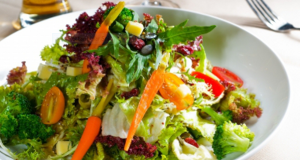Can eating a salad make you sick? Believe it or not, salad greens are at the top of the list of America’s riskiest foods.
Examine the statistics: Leafy greens cause a full 30 percent of the estimated 76 million food-borne illnesses, 325,000 hospitalizations and 5,000 deaths in the U.S. each year.
The Washington-based Centers for Science in the Public Interest tracked data from 1990 and 2006 and revealed which foods caused the most food-poisoning outbreaks during that period:
1. Leafy greens, 363 outbreaks. Greens were found to contain various pathogens, including E. coli, norovirus and salmonella. They often can become contaminated during harvesting or during the pre-washing process for bagged lettuce.
2. Eggs, 325 outbreaks. Most of these outbreaks were from salmonella due to improper handling and cooking. Restaurants were the worst offenders, serving eggs too raw or leaving them too long on buffet tables.
3. Tuna, 268 outbreaks. The primary culprit is something called Scombroid poisoning, a toxin released when fresh fish is stored above 60 degrees F. It can cause headaches, cramps, nausea, diarrhea, palpitations and loss of vision.
4. Oysters, 132 outbreaks. Norovirus is common in tainted oysters and usually comes from the waters in which these delicacies are harvested. A bacterium called Vibrio is also present in oysters, and it can infect the bloodstream and be life-threatening.
5. Potatoes, 108 outbreaks. Outbreaks occur most frequently from contaminated or improperly refrigerated potato salad. The most common causes of potato-linked illnesses are E. coli and salmonella.
6. Cheese, 83 outbreaks. Salmonella is the most common cheese hazard. Although most cheese is made with pasteurized milk, California officials have warned that many Latin-American-style cheeses may be made by unlicensed manufacturers using milk that could contain harmful bacteria. Pregnant women should be cautious about eating soft cheeses like Brie or Camembert, which can carry Listeria. Listeria can cause miscarriage, say experts.
7. Ice cream, 75 outbreaks. Salmonella and staphylococcus, most often from raw eggs in homemade ice creams, were the biggest threat.
8. Tomatoes, 31 outbreaks. Tomatoes were implicated in four multistate outbreaks of salmonella. Restaurants were responsible for 70 percent of tomato-related illnesses.
9. Sprouts, 31 outbreaks. Sprout seeds can become contaminated with salmonella or E. Coli during storage. Because sprouts pose a contamination hazard, the FDA recommends that people with compromised immune systems, the elderly and the very young do not consume raw sprouts.
10. Berries, 25 outbreaks. Berries can be contaminated with hepatitis A or Cyclospora. In 1997 more than 2.6 million pounds of contaminated strawberries were recalled across several states when students became ill with hepatitis A, possibly from an infected farm worker.
Dr. Ellen Kamhi, author of The Natural Medicine Chest, tells Newsmax Health that even the most careful eaters can get food poisoning.
“My advice is to make sure your digestive system is in order because that’s where 70 percent of your immune system is stored,” she says. “Take a probiotic supplement daily to help you ward off food poisoning if you get it. Studies have shown that this can reduce the severity and symptoms.”
Dr. Kamhi also suggests thoroughly washing produce, even if it’s labeled “prewashed” on the package.
The Mayo Clinic offers these tips:
Wash hands, utensils and food surfaces thoroughly.
Keep raw foods separate from cooked food.
Cook foods to a safe temperature to kill bacteria—between 146 and 165 degrees F.
Keep foods hot or refrigerated until serving.
Defrost foods safely in the refrigerator—not at room temperature.
When in doubt, throw it out. If you aren’t sure a food has been prepared, served or stored safely, discard it.
